[Important] Nagomi Visit will have a new operating organization starting September 1.
Your reservations and information remain unchanged.
Learn more
Blog
2019-03-18
We asked Golo, Susann and their 18-month-old daughter Ida who visited Japan for the first time from Germany and decided to go on two Nagomi Visits. One in the Tokyo metropolitan area with a family of four with kids age 3 and 8 and another family of four with kids age 2 and 3 in the suburbs of Tokyo in Saitama Prefecture.
Each Nagomi Visit is unique and this is Golo and his family’s Nagomi experiences.
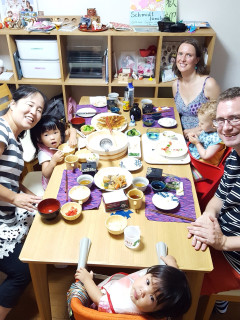

- When you decided to book a Nagomi Visit how did the other members of your family react? Were they excited? Worried?
I found out about Nagomi Visit on a travel website and was immediately thrilled. My wife feels very much the same about traveling and meeting locals, so it wasn't at all difficult to convince her that we should try it out. We were both positively surprised how many answers we got following our request, and the hardest part was to actually choose but two of them.
- How long did it take for your daughter to warm up to the host's home and family? If so, how did they interact with the hosts?
My daughter was a bit shy at that time (18 months old), so she didn't really get into contact with the kids. Instead, she played with their toys (which they gladly allowed) and kept close to Mum and Dad. She loved trying on the baby yukata our second host family provided. She also loved watching the moon from the first host family's balcony together with their daughter.
- Did your daughter enjoy any part of the meal the host made?
When we visited Japan, temperatures peaked at about 38°C. Our daughter didn't like the heat, so she generally ate only little. It wasn't very different at the host family, but both my wife and I enjoyed the food a lot.
- What was the Nagomi experience like as a parent with your daughter?
It was great - I couldn't have expected more.
- Did having your daughter help foster conversation or help you notice things you may have not if you went with just adults?
Sure. As with other German parents, you automatically start talking about your kids. The first host family allowed Ida to participate in the tea ceremony, which she enjoyed a lot. And their elder daughter was so proud helping out that you could feel that Ida wanted to do the same.

- Was participating in a Nagomi Visit different from other travel activities with your daughter? Was it more relaxing since you are in a home with similar age kids and toys? Or did it make you nervous?
Both my wife and I have travelled widely (and also to Asian countries), so we weren't nervous. We were greeted in such a friendly way that any rest of nervousness would have disappeared immediately anyway. Both Nagomi Visits were really quite relaxing as we could get out of the heat and let our daughter play in safe surroundings. As I said above, it was more the toys than the kids she was interested in.

- Why did you decide to go on more than one Nagomi Visit and what did your family gain from meeting more than one Nagomi host?
Our original plan was to do even more Nagomi Visits in all the places we visited, but given our limited time in Japan we were quite happy to settle on only two. With hindsight, though, we should have taken them in two different cities, though, as we missed out on two afternoons in Tokyo. Given that there is so much to see, this was not the best choice. Apart from that, both Nagomi Visits were great. We had a lot of fun with the first family, taking pictures of the kids during the tea ceremony or creating Japanese sweets and origami on our own. The food was excellent, too. The second family was super friendly, too, and we were immediately on the same wavelength. It is always good to meet locals, so if we ever get back to Japan, we will certainly do another Nagomi Visit.
Ready to go on a Nagomi Visit? Start booking here. Need tips or advice? Read Tips for going on a Nagomi Visit with young kids or ask the Nagomi Visit Team!
2019-03-17
We asked Diana and her family from Canada, along with their son's best friend who were traveling to Japan for the first time. Their son is 15 and in high school, and his best friend is 16. They met one of our hosts in Hyogo Prefecture near Himeji and Kobe who are a family of 4 with a 6 and 1-year-old son.
Each Nagomi Visit is unique and this is Diana and her family’s Nagomi experience.
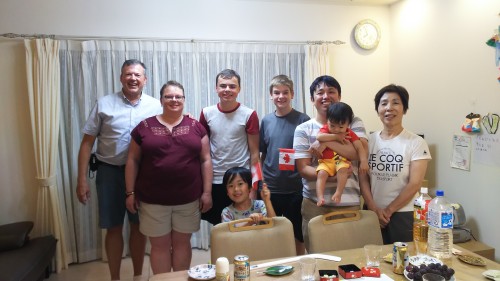
- When you decided to book a Nagomi Visit how did the other members of your family react? Were they excited? Worried?
They were excited. They really liked the idea of visiting a family and experiencing “real life”
- How long did it take for your son and his friend to warm up to the host's home and family? If so, how did they interact with the hosts?
My son and friend were 16 so they warmed up right away with the host family and played with the little boys. We brought them mini hockey sticks as gifts and showed them how to play hockey with them.
- Did your son and his friend enjoy any part of the meal the host made?
They enjoyed all parts of the meal but it felt very special to have Tempura made fresh. I also have allergies to wheat flour and they made special tempura for me with corn starch. They really made us feel special. Even the presentation in bento boxes was beautiful
- What was the Nagomi experience like as a parent with your son and son's friend?
As a parent it was great to see the boys playing with each other even though they didn’t speak the same language. They had a lot of fun.
- Did having your son and son's friend help foster conversation or help you notice things you may have not if you went with just adults?
Having the boys definitely helped us interact with the little boys better. It also gave us lots to talk about, comparing school and activities of the kids.
- Was participating in a Nagomi Visit different from other travel activities with your son? Was it more relaxing since you are in a home? Or did it make you nervous?
It was nice to socialize with a family and was relaxing. We like to travel and it was so nice to experience more than just being a tourist. We were not nervous and it was one of the highlights of our trip, both before and after.
Ready to go on a Nagomi Visit? Start booking here. Need tips or advice? Read 10 Ways to Enjoy a Nagomi Visit or ask the Nagomi Visit Team!
2019-03-16
A big family of 6 from the US Nagomi Visited one of our hosts in Chiba Prefecture, part of the greater Tokyo area. With 4 kids of the ages 4, 8, 10, and 11, they wanted to meet another family with children about the same ages. The host they met has 3 kids of the ages 4, 8, and 9. Their host requested to meet a little early around 3PM instead of the usual 6PM because one of their kids is still a bit too young to stay up too late so the Nagomi fun started a little earlier.
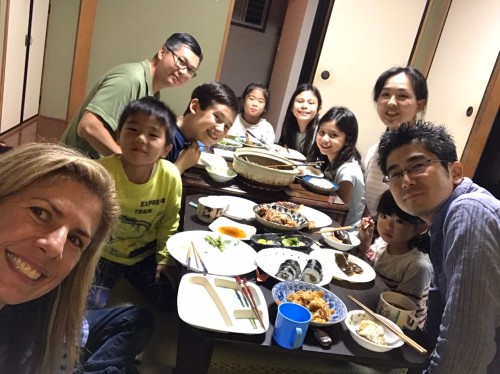
- When you decided to book a Nagomi Visit how did the other members of your family react? Were they excited? Worried?
When I booked the nagomi visit, everyone was very excited. No one was nervous or scared. Sawako also made the visit stress free for us by meeting us at the train station and walking us back as well.
- How long did it take for your kids to warm up to the host's home and family? If so, how did they interact with the hosts?
Our children were comfortable with the host’s home and children in a matter of minutes. They could not communicate verbally, but they had fun folding origami together and engaging in physical humor.
- Did your kids enjoy any part of the meal the host made?
Our kids did not recognize some of the food, and thus avoided about half of the offerings. However, everybody was able to find plenty to eat. I would not want the host to attempt to serve more American style food as that would detract from the purpose of the visit, which I see is a sharing of cultures.
- What was the Nagomi experience like as a parent with your kids?
The nagomi experience was wonderful. We will certainly do it again when we return to Japan. We also have maintained contact with the family and are friends. They are welcoming, kind, and generous. We will certainly visit with them again. As a parent, I was amazed at how well the children got along and played together.
- Did having your kids help foster conversation or help you notice things you may have not if you went with just adults?
Watching the kids interact was fun, but I’m not sure if the children’s presence enhanced my ability to appreciate the visit or not.

- Was participating in a Nagomi Visit different from other travel activities with your kids. Was it more relaxing since you are in a home with similar age kids and toys? Or did it make you nervous?
The activity was very different than any other activity we did on our trip, but was perhaps the most special. We enjoy meeting people, and we admire Japanese culture. So, being able to spend time with a Japanese family was an amazing opportunity for our family. I think our children would have also enjoyed spending a half day in a Japanese school.
Ready to go on a Nagomi Visit? Start booking here. Need tips or advice? Read Tips for going on a Nagomi Visit with young kids or ask the Nagomi Visit Team!
2019-03-15
We asked Hauke and Alexandra who visited Japan for the first time from Germany and visited one of our hosts in Tokyo, a family of three with one daughter.
Each Nagomi Visit is unique and this is Hauke and Alexandra’s Nagomi experience.
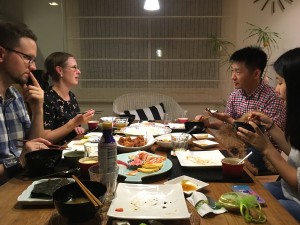
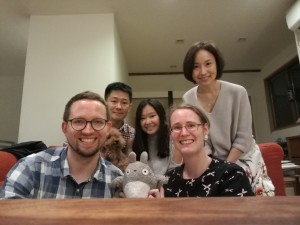
- When you decided to book a Nagomi Visit how did your partner react? Were they excited as much as you? Worried?
We decided together to book a Nagomi Visit (we saw it on a German TV show about traveling in Japan) and we were both very excited. We liked the idea immediately and were convinced from the concept.
- How long did it take for you and your partner to warm up to the host and their home?
Seconds. :-) We had a really warm welcome at the train station and a nice ride to their home. When we arrived and during the great dinner, the conversation went on very easily because we had a lot of things in common, for example similar interests in culture, movies and sports.
- Did you learn anything seeing and experiencing life from inside a Japanese home?
Yes, we admired their smart solutions for storage and the estatic interior design. And to drink sometimes a sake before having a good meal. We also talked about the actual political situation in Japan and in Germany, and we learned a lot.
- Did having someone with you help foster conversation or help you notice things you may have not if you went by yourself?
It was just me and my wife, and we got a long very well. One family-member of our host lived in Germany for some time in his youth, that made it very easy to get connected.
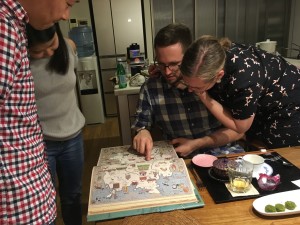
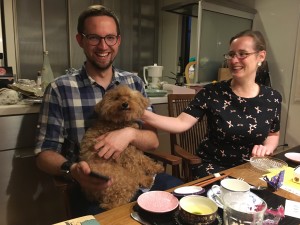
- Was participating in a Nagomi Visit different from other travel activities with your partner. Was it more relaxing since you are in a home with someone? Or did it make you nervous?
It was very relaxing in their home and we got a very good impression of the Japanese home-culture. It was a unique experience, to meet people in their home and not just doing touristic activities like sightseeing. It's important to us, trying to meet locals while we are traveling, to get an impression of their life and culture.
- Was there anything you thought differently about Japan after going on the Nagomi Visit?
We tried to do our traveling unprejudiced. After the Nagomi Visit we feel confirmed, that it is important to meet people. We noticed, that we've got a lot in common, despite the cultural differences. One thing, what was surprising for us was, that more Japanese people are having problems to digest alcohol than we expected. ;-)
- Do you have any advice for future Nagomi Visitors?
Yes, try to find a date at weekends. It seems to be easier because we tried to find Nagomi Visits in Kanazawa and Kyoto during the week, but there were no offers. In Tokyo we had one offer during the week but more for the weekend.
Ready to go on a Nagomi Visit? Start booking here. Need tips or advice? Read 10 Ways to Enjoy a Nagomi Visit or ask the Nagomi Visit Team!
2019-03-14
We asked Cheryll and Felix who visited Japan for the first time for their honeymoon and visited one of our hosts, a couple in Nara.
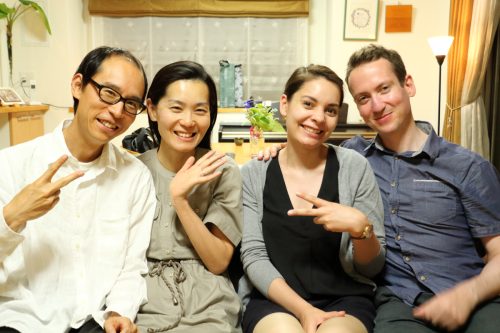
Each Nagomi Visit is unique and this is Cheryll and Felix’s Nagomi experience.
- When you decided to book a Nagomi Visit how did your partner react? Were they excited as much as you? Worried?
I read about Nagomi Visit in an Instagram-Post and was immediately hooked, but when I told Felix about it, he was a bit sceptical. We are both not too outgoing, so visiting people you've never met, and whose language you don't speak, "just like that" probably felt a bit weird. But I was pretty excited about that idea, so he agreed - and in the end we are more than happy about our day with Naru and Kaori.
- How long did it take for you and your partner to warm up to the host and their home?
Not long at all! Naru and Kaori met us as the train-station, well prepared with a map and additional info-material (they're quite experienced Nagomi Hosts). They are a lovely couple and I wrote some emails with Naru beforehand, so I felt no need to be nervous. We went for a stroll right away, and learned so much about Nara and Japan in general. Naru even brought his camera and shot some photos (I'll attach some).
- Did you learn anything seeing and experiencing life from inside a Japanese home?
We learned most by talking to Naru and Kaori, who patiently answered thousand of questions, but of course, we saw some interesting differences to German/European apartments. Food-wise, we were pretty lucky - Kaori is well versed about japanese tea-ceremonies and we got an impressive demonstration in their tea-room. Also, we had an amazingly rich dinner* and saw how she made Okonomiyaki, I guess that counts as learning :)
*I'm a bit sad that we forgot to take a picture BEFORE we finished eating -.-'

- Did having someone with you help foster conversation or help you notice things you may have not if you went by yourself?
Definitely! Before dinner, we went to the Park in Nara, visited shrines and temples and Naru and Kaori explained so much to us. We would've never learn so much about Nara and Japanese Culture if we went by ourselves - and probably would've missed out some beautiful places Naru showed us as well.
- Was participating in a Nagomi Visit different from other travel activities with your partner? Was it more relaxing since you are in a home with someone? Or did it make you nervous?
The only other activity we booked was a day at the Sumo-Tournament in Tokyo, so it is hard to compare to our experience with Nagomi Visit. But being at Naru and Kaori's place didn't make us nervous at all, we got to know them a little on our little tour through Nara and after that (it was a pretty hot day), we were pretty happy to arrive at their apartment for tea, dinner and a little break.
- Was there anything you thought differently about Japan after going on the Nagomi Visit?
Maybe not so much differently, but there are some things we thought more about, after spending the day with our hosts - for example the japanese working morale, the day to day life and so on.
- Do you have any advice for future Nagomi Visitors?
Just go for it and don't be afraid! Of course, there's no guarantee that every host is as great as ours were ;) - but spending time with locals is an amazing, enriching experience that you shouldn't miss.
Ready to go on a Nagomi Visit? Start booking here. Need tips or advice? Read 10 Ways to Enjoy a Nagomi Visit or ask the Nagomi Visit Team!
2019-03-13
We asked Valentina and Sirio who visited Japan for the first time from Italy and met two of our hosts, one in Tokyo and another in Osaka.
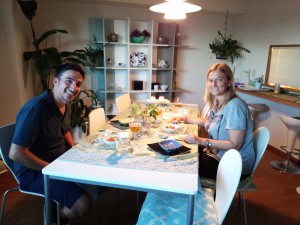
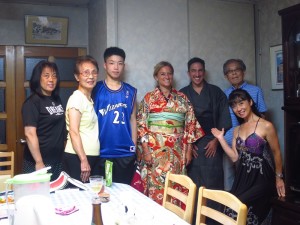
Each Nagomi Visit is unique and this is Valentina and Sirio’s Nagomi experience.
- When you decided to book a Nagomi Visit how did your partner react? Were they excited as much as you? Worried?
My partner Sirio was enthusiastic and happy to share these experience because we are curious and interested to know different people and cultures during our trips. We was very excited, probably a little worried at first, but then not.
- How long did it take for you and your partner to warm up to the host and their home?
No much time in both visit. During the first in Tokyo, the family was numerous and funny, it was very simple to start conversation. Also, in Osaka, the Miss who hosted us was very interesting person and we have talk about everything
- Did you learn anything seeing and experiencing life from inside a Japanese home?
Yes, it was a very important experience to know new things about Japanese culture, daily life, food, religion, society and life organization
- Did having someone with you help foster conversation or help you notice things you may have not if you went by yourself?
To be in two people, probably, is better because there is more variety in the conversation and is possible talk with different members of the family at the same time
- Was participating in a Nagomi Visit different from other travel activities with your partner. Was it more relaxing since you are in a home with someone? Or did it make you nervous?
Absolutely happy and at ease
- Was there anything you thought differently about Japan after going on the Nagomi Visit?
Yes, the Japan is a country that you can imagine but is not never like reality. We improved our skills about language, culture, food, lifestyle and society
- Why did you decide to go on more than one Nagomi Visit and what did you gain from meeting more than one Nagomi host?
When I decided to participate to Nagomi Visit I could try to go to one host in every stop of our journey and where it was possible we took advantage of it because I think is one of most important opportunity to know and meet people of different country like Japan
- Do you have any advice for future Nagomi Visitors?
Yes, it is important choose as many as possible opportunities like this to share your travel experience in Japan with other people
Ready to go on a Nagomi Visit? Start booking here. Need tips or advice? Read What did you learn from visiting more than one host? or ask the Nagomi Visit Team!
2018-03-21
Time Out Tokyo was kind enough to feature Nagomi Visit. What was most exciting about the article was that it explained our name Nagomi Visit.
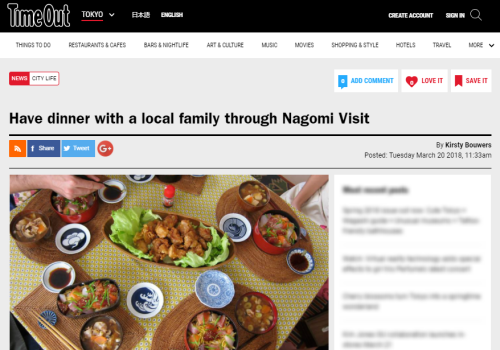
It had been awhile since an article covered the meaning behind our name. The article provided an opportunity to reflect on our name which holds a lot of meaning about our mission as an organization.
"The name shows this too: 'Nagomi' is an alternative reading of the kanji 和, which refers to all things Japanese, yet can also mean 'bring together'. Make a verb (nagomu or nagomi) out of it, and it refers to the feelings you have when spending time with good friends – precisely the feeling which Nagomi Visit hopes to evoke."
We also appreciate them taking the time to highlight the fact that we are a nonprofit and our reasons for choosing to be one.
Arigato, Time Out Tokyo.
2018-03-01
Since Nagomi Visit received The Japan Foundation Prizes for Global Citizenship from the Japan Foundation, we find ourselves in unexpected situations.
Such as on Japan's Ministry of Foreign Affairs of Japan website.

The two of us, Nagomi Visit's founder and myself the COO of the organization are standing in the middle of the group photo. To the left is a member of the House of Representatives who spoke at the ceremony. He is part of the Committee of Financial Affairs and all of us at Nagomi Visit including a few hosts had the great honor but a bit surreal experience being able to speak with him.
The whole experience of being in an awards ceremony was already very new but who knew we would find ourselves on the Japanese government's website as part of their foreign relations news.
It sure is a new day for Nagomi Visit.
Arigato again to all our hosts who came to the ceremony to celebrate with us. We also would like to take this opportunity to of course thank everyone who participated as guests. We are just stating an obvious fact but if it weren't for all of you participating we wouldn't be here so, arigato.
2018-01-30
Arigato to Japan's most well known English magazine Metropolis for covering Nagomi Visit.
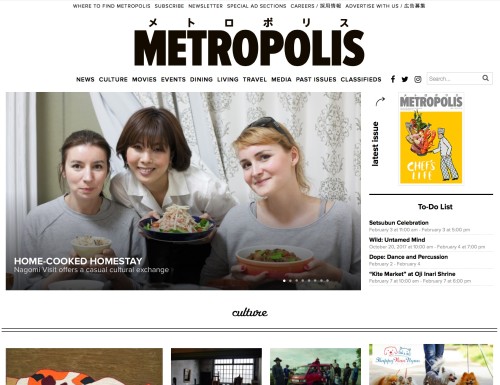
Looking forward to foreign residents in Japan joining a Nagomi Visit "to experience a part of Japan away from tourist hotbeds and outside the expat bubble."
As mentioned in the article, to participate in a Nagomi Visit "No Japanese is required—all hosts have some level of English speaking ability—the goal is simply to learn about everyday Japan over a home-cooked meal."
However, if you are currently studying your "Kanji flashcards and Genki textbooks" we welcome you to test out your Japanese!
2018-01-24
Founder Megumi Kusunoki and two of our amazing Nagomi Visit hosts spoke at a press conference where they announced Nagomi Visit will be receiving The Japan Foundation Prizes for Global Citizenship for 2017.
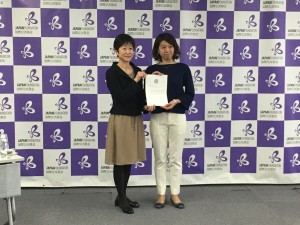
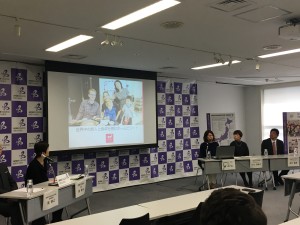
Yesterday marked 5 amazing years since we registered as a nonprofit organization on January 23rd, 2013. We are still a small three person team running the whole organization but with many more hosts and guests thanks to all of you.
So what is this award?
The Japan Foundation is a cultural institution that aims to promote cultural exchange, originally founded by the Government of Japan.
"The Japan Foundation Prizes for Global Citizenship is intended to support organizations based in Japan that endeavor to strengthen networks among citizens both inside and outside Japan, and share the knowledge, idea and expertise through Intercultural Exchange."
The awards ceremony will be at the end of February 2018 so we look forward to sharing our experiences soon. In the meantime we would like to say arigato to all of you who led us through this incredible journey.
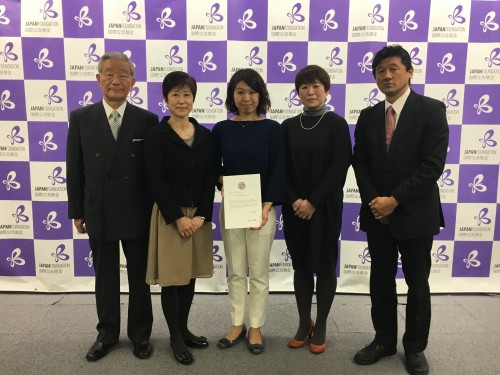




 Nagomi Visit
Nagomi Visit


















